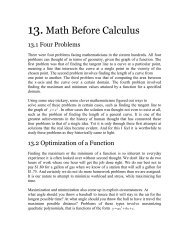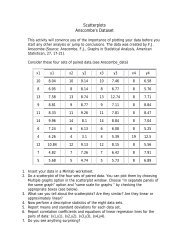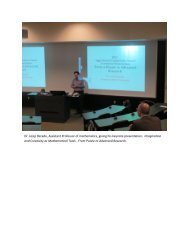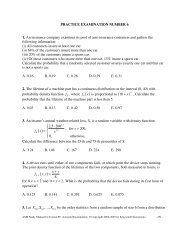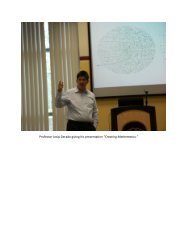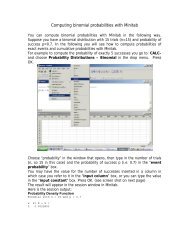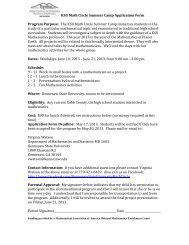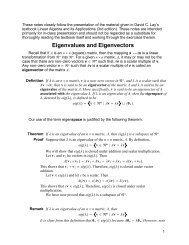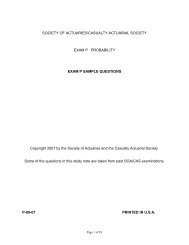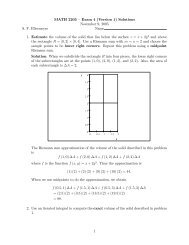EXAM P SAMPLE SOLUTIONS
EXAM P SAMPLE SOLUTIONS
EXAM P SAMPLE SOLUTIONS
You also want an ePaper? Increase the reach of your titles
YUMPU automatically turns print PDFs into web optimized ePapers that Google loves.
31. Solution: D<br />
Let X denote the number of employees that achieve the high performance level. Then X<br />
follows a binomial distribution with parameters n= 20 and p = 0.02 . Now we want to<br />
determine x such that<br />
Pr X > x ≤ 0.01<br />
[ ]<br />
or, equivalently,<br />
[ ] ( )( ) ( ) 20<br />
x 20<br />
k −k<br />
0.99 ≤Pr X ≤ x =∑ 0.02 0.98<br />
k = 0 k<br />
The following table summarizes the selection process for x:<br />
x Pr X = x Pr X ≤ x<br />
[ ] [ ]<br />
(<br />
20<br />
) =<br />
0 0.98 0.668 0.668<br />
( )( )<br />
1 20 0.02 0.98 = 0.272 0.940<br />
19<br />
( ) ( )<br />
2 18<br />
2 190 0.02 0.98 = 0.053<br />
0.993<br />
Consequently, there is less than a 1% chance that more than two employees will achieve<br />
the high performance level. We conclude that we should choose the payment amount C<br />
such that<br />
2C = 120,000<br />
or<br />
C = 60,000<br />
--------------------------------------------------------------------------------------------------------<br />
32. Solution: D<br />
Let<br />
X = number of low-risk drivers insured<br />
Y = number of moderate-risk drivers insured<br />
Z = number of high-risk drivers insured<br />
f(x, y, z) = probability function of X, Y, and Z<br />
Then f is a trinomial probability function, so<br />
Pr [ z ≥ x+ 2] = f ( 0,0, 4) + f ( 1,0,3) + f ( 0,1,3 ) + f ( 0, 2, 2)<br />
=<br />
= 0.0488<br />
+ +<br />
4!<br />
+<br />
2!2!<br />
4 3 3 2<br />
( 0.20) 4( 0.50)( 0.20) 4( 0.30)( 0.20) ( 0.30) ( 0.20)<br />
Page 13 of 55<br />
2



